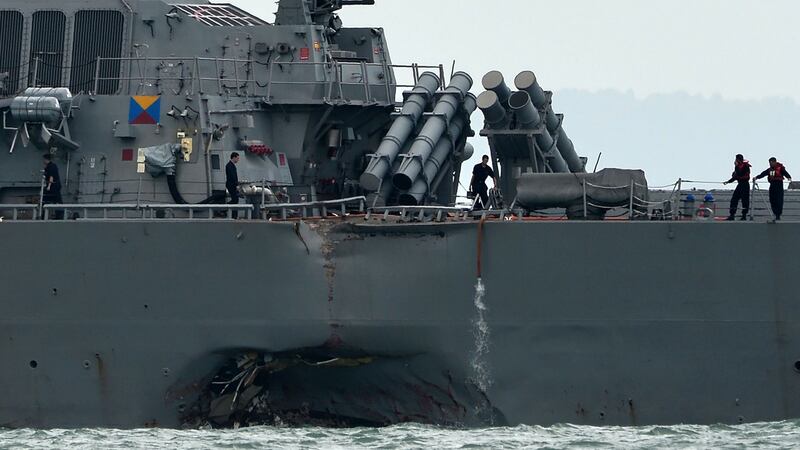The US navy has ordered an investigation into the practices of its Pacific-based Seventh Fleet after a fatal collision involving the USS John S McCain and an oil tanker near Singapore.
Ten sailors were missing and five injured after Monday’s accident, the second involving a naval destroyer from the US Seventh Fleet and a commercial vessel in just over two months.
Navy Admiral John Richardson, the chief of naval operations, said he had ordered an “operational pause” for all US fleets around the world so commanders could ensure the navy was taking “all appropriate immediate actions to ensure safe and effective operations around the world”.

Adm Richardson said he had also ordered a broader “comprehensive review” to determine the “root cause” of the recent collisions.
“This requires urgent action. We need to get to it and take corrective action . . . we need to get to the bottom of this,” he said in a video statement.
An international search effort involving Singaporean naval, coast guard and commercial vessels is under way after the incident occurred in one of the world’s busiest shipping lanes.
The John S McCain, a guided missile destroyer, was in a collision with the oil tanker Alnic MC at 5.24am local time when it was "transiting to a routine port visit in Singapore", according to the US navy. The navy later said the destroyer had docked at Singapore's Changi naval base with "significant damage" to the hull, which resulted in "flooding to nearby compartments including crew berthing, machinery and communications rooms".
President Donald Trump, asked about the collision by reporters at the White House on Sunday night, said, "That's too bad." He later offered his "thoughts & prayers" on Twitter to the sailors aboard the ship.
Large gash
Images posted on social media by the Royal Malaysian Navy’s chief showed the US vessel riding low in the water with what appeared to be a large gash in its port side. The US navy also said the tanker “sustained damage to her fore peak tank seven metres above the waterline, with no crew injuries”.
The Alnic MC is a Liberian-flagged 183-metre oil and chemical tanker with a gross tonnage of 30,000 – dwarfing the John S McCain's 9,000. Shipping data showed that, after the incident, the Alnic MC was stationary about 20km off the Pengerang peninsula in southern Malaysia. The same data shows that it was not carrying oil or chemicals.
The accident followed an earlier collision involving a naval destroyer from the Seventh Fleet and a commercial vessel. In June the USS Fitzgerald collided with a Philippine-registered container ship in waters off Japan, killing seven crew members. The captain of the Fitzgerald was relieved of his command after an investigation described the disaster as "avoidable".
The two destroyers, which are both part of the region’s ballistic missile defence shield, share the same home port of Yokosuka in Japan. They are part of a small group of ships that perform regular ballistic missile defence patrols in an area where tensions are high and have been ratcheted even higher as fears over North Korea’s military capability grow.
‘Fire and fury’
Last week, in response to unscripted comments from US president Donald Trump in which he warned Pyongyang about the US unleashing "fire and fury" on the regime, North Korea threatened it would fire missiles towards the US territory of Guam. The escalation of rhetoric has prompted Japan to propose "radical" upgrades in its own missile defence systems.
Concerning Monday's incident, the ship tracking data, which is not available for the John S McCain, suggest the Alnic may have attempted to move to avoid an obstacle. Upon their approach to Singapore, vessels enter a traffic regime that separates the channel into two lanes guiding ships in opposite directions. The available data, say analysts at Jane's IHS Markit, suggest that the tanker was in the correct lane and conforming to its rules at the time of the collision.
Jane's naval expert Ridzwan Rahmat noted that the US navy vessel had been recently involved in challenging Beijing's territorial claims in the South China Sea – a mission of high sensitivity.
The succession of accidents, he said, could raise questions over whether the US navy had become too stretched in the region and whether the tempo of operations involving this class of ship was becoming unsustainable.
Copyright The Financial Times Limited 2017
















